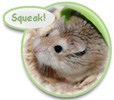Winter White Hamster
From Hamster Central WIKI
During the 1960’s the winter whites were used as lab animals in Czechoslovakia. Two pairs were brought to a lab in Germany and from there made their way into the pet market.
Winter white hamsters ”Phodopus Sungorus" are also know as the Siberian hamster or the Djungarian hamster. The winter white hamster is from eastern Kazakhstan and southwest Siberia. In the winter their coasts change from dark to white and will do the same in captivity provided that their cages are illuminated with natural light. Although some may not change completely white.
The Winter White Russian Hamster is the least common of the two species of Dwarf Russian Hamster kept as pets and is therefore rarely seen in pet shops. The Dwarf Winter White Russian is sometimes also known as the Siberian Hamster. Many pet shops will have Siberian hamsters but in most cases this is probably not the winter white but in fact a Dwarf Campbells Hamster. To be certain of what you are getting you may want to seek out a breeder of winter whites. Another name used is Djungarian or Dzungarian in both the Dwarf Campbells Hamster and occasionally Winter Whites. The Djungarian inst a new special species of Dwarf, simply just another name.
The winter white hamster measures up to four inches (10cm) in length. During the summer they are a dark gray-brown with a light colored underbelly. They have a dark dorsal stripe as well as a black stripe on each side separating the dark gray top and light gray belly. As the days grow shorter the dark coat will be replaced with a white coat.
Breeding has brought in two new colors being the sapphire a blue-gray colored with a dark dorsal stripe the other being a peal white with a white body ticked with gray hairs and a darker head, neither of these colored hamster change their coast with the season.
Winter White Hamsters are sociable and will live with others of its own kind in single or mixed sex groups provided that hamsters are introduced at a young age. They make good pets although because of their small size they can be difficult for small children to handle. The Dwarf Winter White Russian Hamster can also be less tolerant of clumsy handling than the bigger Syrian Hamster but is generally nice natured.
Due to their size cages designed for mice, glass or plastic aquariums make more suitable cages. The average lifespan of the Dwarf Winter White Russian Hamster is 1½-2 years although they can live longer.
Although they come from a very cold climate the winter white hamster does not hibernate but will sleep in a few hours longer in the morning.
Breeding Dwarf Russian Hamsters is much simpler than breeding Syrian Hamsters as they will live together in mixed sex pairs or groups and breed naturally. Pairs or groups are best established at a young age as introducing older hamsters can often result in fighting. Although they may be simpler to breed, breeding Dwarf Russian Hamsters should not be undertaken lightly as being kept together they can produce a succession of litters as little as 3 weeks apart.
Females often become sterile at around 12 months of age but males usually remain fertile for most of their life.



